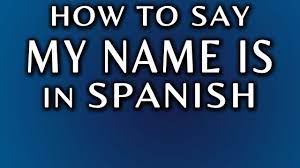When it comes to navigating the intricate tapestry of a new language, learning essential phrases is akin to unlocking the door to a new world.
Imagine each word as a key, granting you access to a richer cultural experience.
But what if you find yourself in a foreign land, needing to introduce yourself but unsure of the right words to use?
Fear not, for mastering the simple yet crucial phrase ‘My name is’ in Spanish can open up a myriad of opportunities for connection and understanding.
Basic Greetings in Spanish
If you want to greet someone in Spanish, you can simply say ‘Hola,’ which means ‘Hello.’ This basic greeting is widely used in Spanish-speaking countries and is a friendly way to start a conversation.
Another common greeting is ‘Buenos días,’ which means ‘Good morning,’ typically used before noon. For the afternoon, you can say ‘Buenas tardes,’ meaning ‘Good afternoon.’ In the evening or night, ‘Buenas noches’ is the appropriate greeting, translating to ‘Good evening’ or ‘Good night.’
Aside from these standard greetings, you may also hear informal greetings like ‘¿Qué tal?’ which is similar to asking ‘How’s it going?’ or ‘What’s up?’ For a more formal approach, especially with strangers or in professional settings, you can use ‘Mucho gusto’ to express ‘Nice to meet you.’
These basic greetings will help you initiate conversations and show respect for the Spanish language and culture.
Introducing Yourself: ‘My Name Is
To introduce yourself in Spanish, simply say ‘Mi nombre es’ followed by your name. This is the most common and straightforward way to let others know your name in Spanish. For instance, if your name is Maria, you’d say ‘Mi nombre es Maria.’
Using this expression is a great way to start conversations and make connections with Spanish speakers. It shows that you’re making an effort to communicate in their language and can help break the ice when meeting new people. Remember to pronounce your name clearly after saying ‘Mi nombre es’ to ensure that you’re understood.
Additionally, if you want to be more casual and friendly when introducing yourself, you can use the contraction ‘soy’ instead of ‘nombre es.’ So, you could say ‘Soy Maria’ to informally introduce yourself. This slight variation can make your introduction sound more relaxed and natural in informal settings. So, feel confident and try out these simple phrases to start introducing yourself in Spanish!
Formal and Informal Expressions
Let’s now shift our focus to distinguishing between formal and informal expressions in Spanish.
When introducing yourself formally in Spanish, you’d typically use the pronoun ‘yo’ followed by the verb ‘soy’ to say ‘I am.’ For instance, ‘Yo soy Juan’ means ‘I am Juan.’ This form is more appropriate when speaking to individuals who are older than you, in positions of authority, or in professional settings.
On the other hand, when addressing peers, friends, or family members, you can opt for a more casual approach. In informal settings, it’s common to drop the pronoun ‘yo’ and simply say ‘Soy’ followed by your name. For example, ‘Soy María’ means ‘I am María.’ This informal way of introducing yourself is suitable for conversations with people of similar age or social status.
Remember to consider the context and relationship dynamics when deciding whether to use formal or informal expressions in Spanish introductions.
Additional Phrases for Introductions
Exploring a variety of greetings and salutations can enhance the richness of your introductions in Spanish. Apart from saying ‘My name is,’ you can use other phrases to introduce yourself.
For instance, you could say ‘Mucho gusto’ to express pleasure in meeting someone, or ‘Encantado/a’ to show you’re delighted. If you wish to ask someone’s name, you can say ‘¿Cómo te llamas?’ which means ‘What’s your name?’ Respond to this question with ‘Me llamo’ followed by your name.
To inquire about how someone is doing, you can use ‘¿Cómo estás?’ for informal settings or ‘¿Cómo está usted?’ when being more formal. Politeness is key in Spanish culture, so remember to use ‘por favor’ (please) and ‘gracias’ (thank you) when appropriate.
These additional phrases not only help you introduce yourself but also facilitate building connections with others in Spanish-speaking environments.
Practice Makes Perfect: Role-Playing Exercises
Enhancing your Spanish language skills through role-playing exercises can significantly improve your ability to confidently introduce yourself and engage in conversations with others. Role-playing allows you to practice real-life scenarios in a safe and controlled environment, helping you gain the confidence needed to communicate effectively in Spanish.
By taking on different roles, such as introducing yourself to a new acquaintance or ordering food in a restaurant, you can familiarize yourself with common phrases and expressions.
During these exercises, focus on pronunciation, vocabulary, and grammar to refine your Spanish speaking skills. Engaging in role-plays regularly can also help you become more comfortable with spontaneous conversations and think on your feet.
Additionally, receiving feedback from a language partner or instructor can provide valuable insights into areas where you can improve.
Frequently Asked Questions
When introducing yourself in Spanish, focus on pronouncing each syllable clearly. Practice saying common phrases like “Hola, me llamo” to perfect your accent. Listen to native speakers and imitate their pronunciation for better results.
When introducing yourself in Spanish-speaking countries, remember to maintain eye contact, use a firm handshake, and show respect by using formal titles like “Señor” or “Señora.” Being polite and courteous goes a long way.
When someone says ‘my name is’ in Spanish, common responses include ‘mucho gusto’ (nice to meet you) or ‘encantado/a’ (delighted). These phrases show politeness and warmth when meeting someone new.
Conclusion
Now that you’ve learned how to say ‘my name is’ in Spanish, you’re well on your way to mastering essential phrases for introductions.
Practice using these phrases in real-life situations to build confidence and fluency in the language.
Remember, communication is key in any language, so keep practicing and don’t be afraid to make mistakes.
¡Buena suerte! (Good luck!)
¡Adiós! (Goodbye!)
¡Hasta luego! (See you later!)


